Growth is a new job function that is ever-evolving and can mean different things depending on your niche or industry.
Your company might not even call it a Growth team yet!
Because of those factors, there isn’t a universal rubric for evaluating your Growth team members.
As a Growth Leader, accurately evaluating your organization and team members is a very important, and time-consuming, part of the job.
But if we plan on creating an engaging career path for future Growth Leaders, we need a process to provide objective feedback across the whole team. This is where the Growth Competency Model comes in.
The Growth Competency Model provides a framework that can be used by Growth Leaders to identify and close gaps in their team, as well as to provide direct feedback and career development advice to their team members.
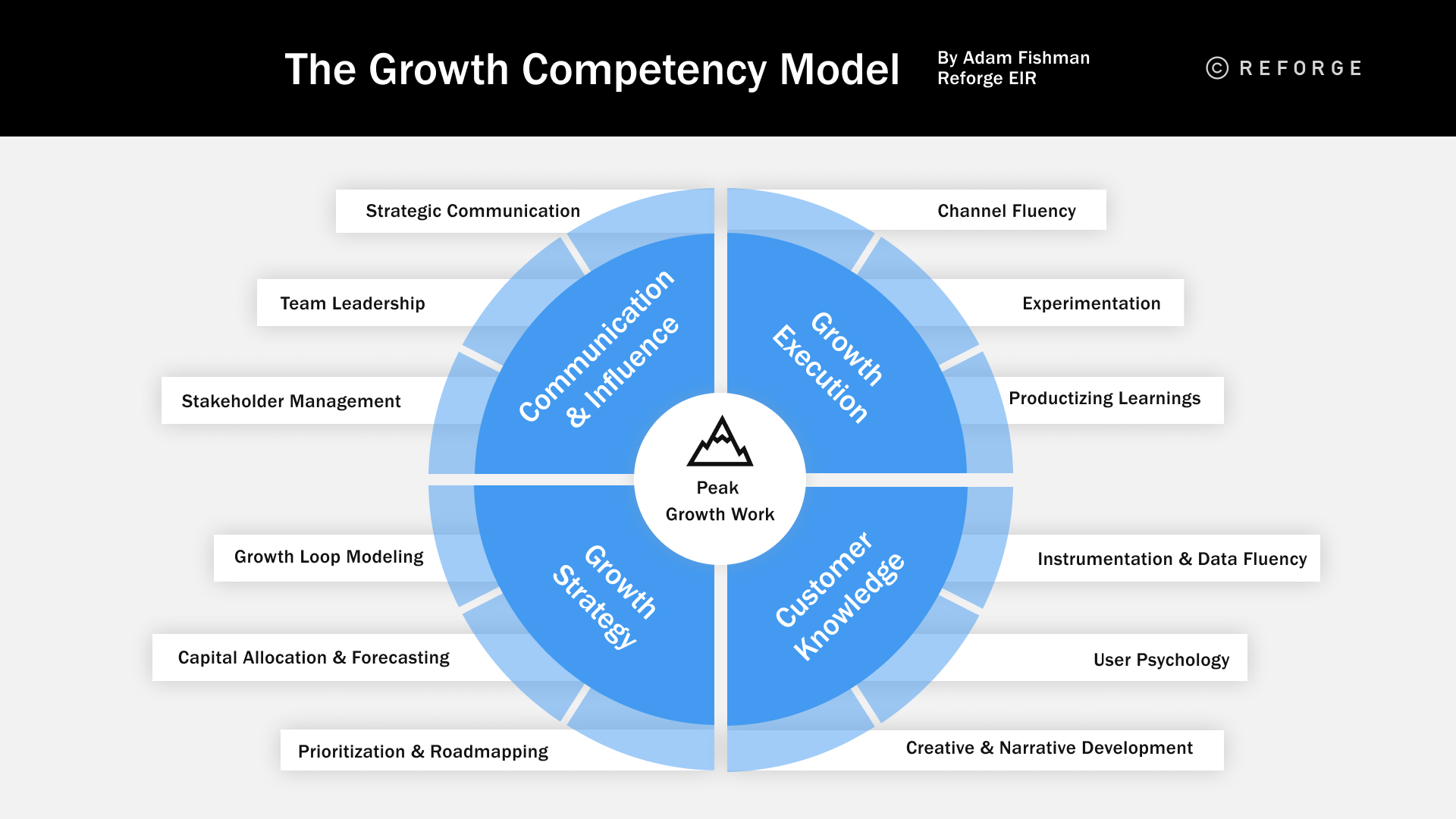
In this post we’ll deep-dive into the Growth Competency Model – covering why we need it, breaking it down into its parts, and walking through how to implement it at your company.
What Is The Growth Competency Model?
The ideas behind the Growth Competency Model emerged from two places.
First, I have been asked the same questions repeatedly.
Questions like:
What do the best growth practitioners look like? What makes them great? How do I hire and manage them? How do I know if my organization has what it needs?
And second, my observations on the strengths and behaviors of the best Growth practitioners I have ever worked with.
With these people, you could easily point to a handful of reasons for their outsized impact on the company and our customers. In other words, they were strong in certain areas that made them indispensable within the Growth Team.
It’s important to remember that your team members won’t spike on every aspect of the Growth Competency Model and that’s okay. Your goal as a leader is to build a well-rounded team that collectively avoids competency gaps.
The Growth Competency Model will not only help you outline what those skills are but also develop a feedback framework that you can use to guide your entire team.
The best leaders deliver insightful feedback to team members in a way that shapes their entire organization and leads to maximum impact.
In our Product Leadership program, we called this the Exponential Feedback Loop. With a few modifications, Growth Leaders can leverage the same framework.
There are some similarities and differences between the Growth and Product Competency Model.
For example, while they both require excellent Strategy skills, that competency looks very different across the two roles.
In a Growth role, Strategy Creation requires a deep understanding of how your product grows so you can connect more customers to the product. Your ability to create individual Growth Loop Models as well as comprehensive, end-to-end Growth Models is paramount to shaping your Growth roadmap.
On the other hand, in a Product role, you need to develop a deep understanding of the vision and roadmap of your product to solve customer problems in order to drive business impact.
Ultimately, the Growth Competency Model powers your Exponential Feedback Loop which allows you to systematically help team members improve in a compounding way.
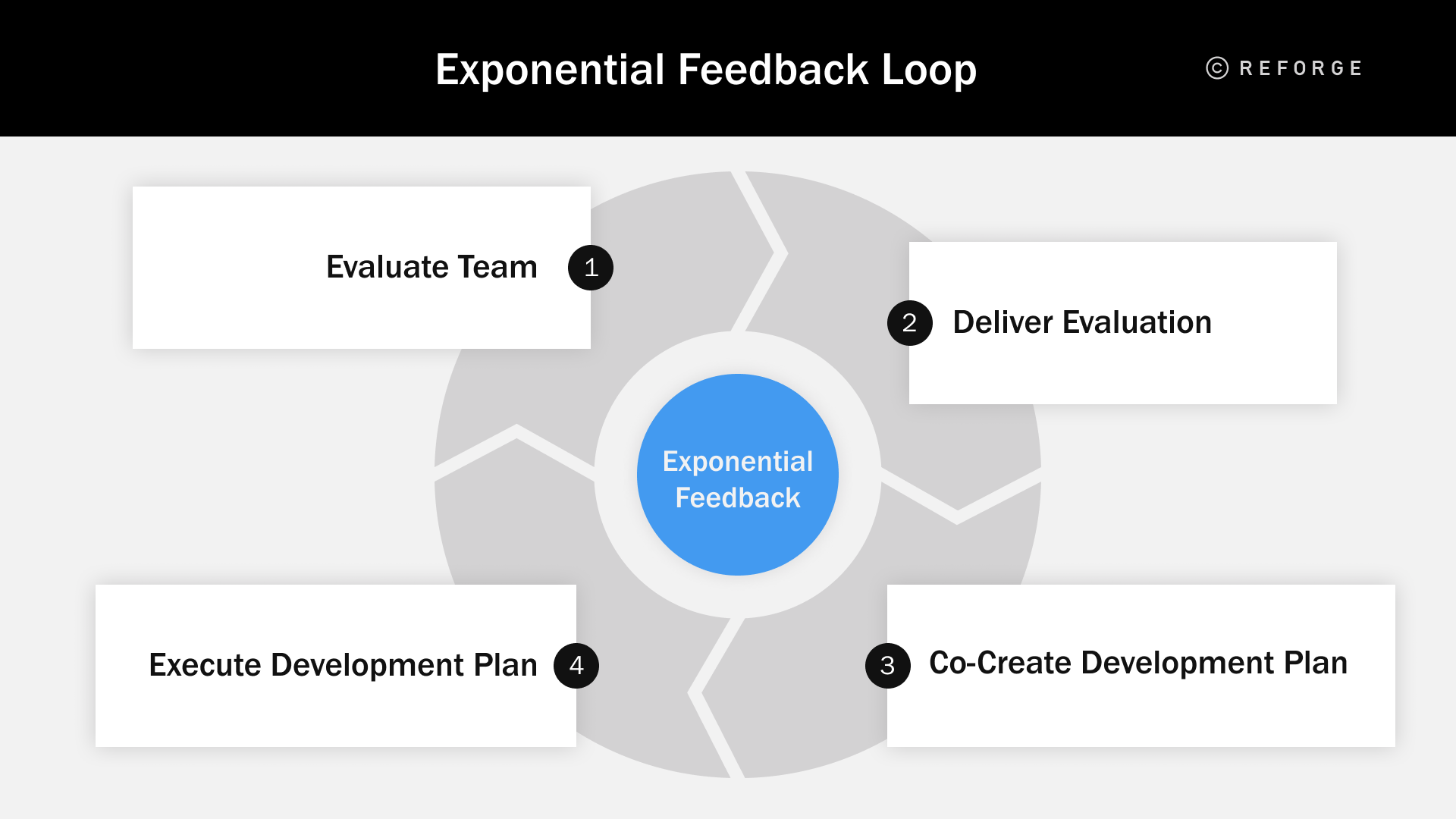
You can use the Competency Model to:
-
Evaluate your team member’s performance
-
Deliver the performance feedback in a structured manner
-
Co-create a development plan to address that feedback
-
Execute that plan through continuous feedback in 1:1s and real-time
Now that you know what the competency model is, and why I developed it, let’s talk about why we need it.
Why Do We Need The Growth Competency Model?
Before creating the Growth Competency Model, I frequently used a concise rubric to evaluate all team members and provide feedback. Even if my company didn’t have a feedback framework.
These ever-evolving rubrics provided much-needed process transparency to my team members around a topic that is relatively opaque.
It made my team, and company as a whole, a more attractive place to work because there was a clearly communicated growth path for team members with a shared language for discussing feedback.
And the organizational outcomes were clear. They could recruit talent, retain employees, and increase their engagement which led to better long-term business results.
Most importantly it made my job easier. As a leader, who wouldn’t like that?!?
The Growth Competency Model also is built specifically for Growth teams.
Throughout my career, I found that the traditional methods of performance management and evaluation are outdated for Growth practitioners.
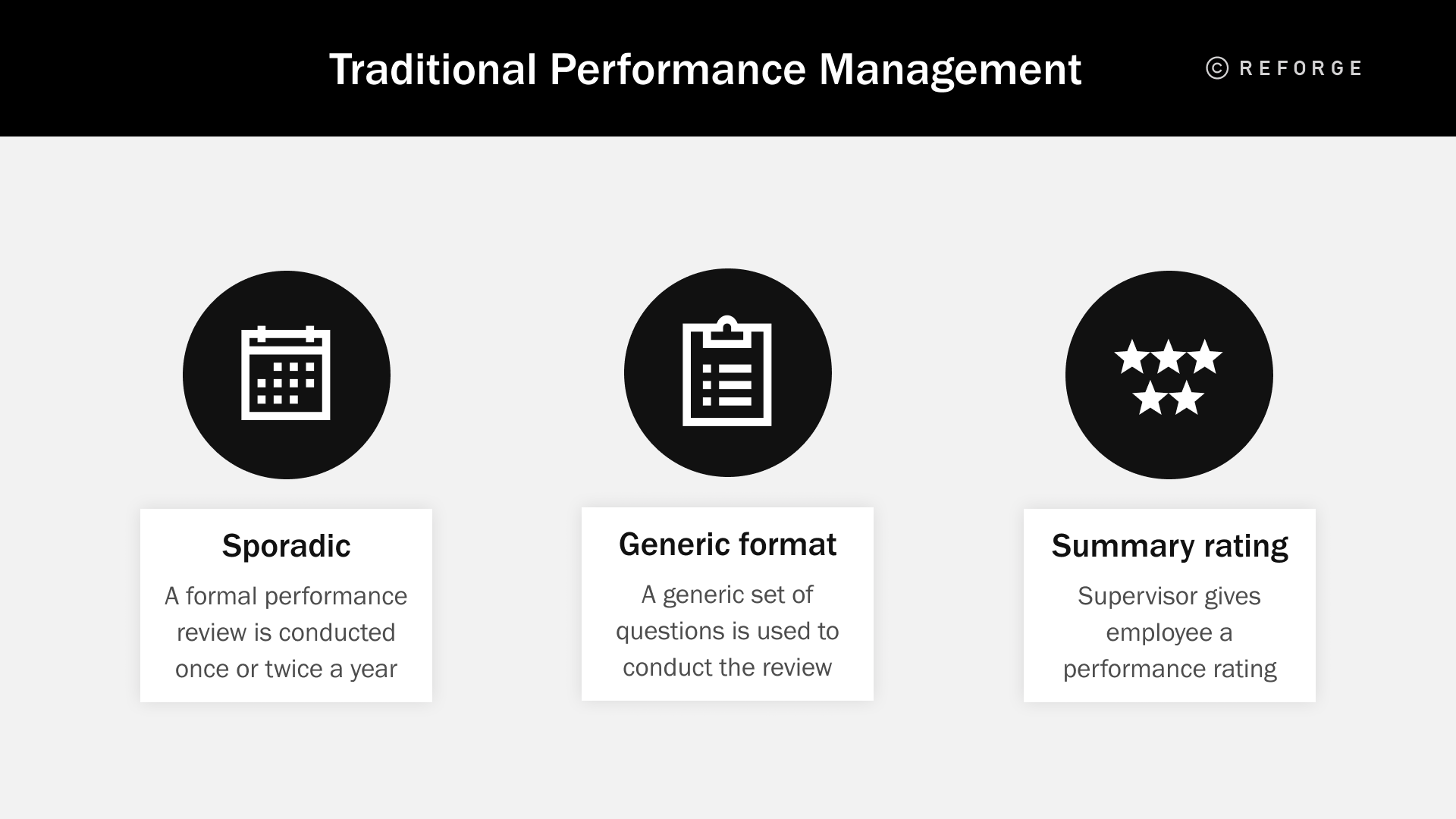
These methods often fail Growth leaders because they solely focus on outcomes instead of the skills you have and the work you actually deliver.
And yes, outcomes are important but some people inadvertently stumble into a positive end result while others miss it entirely.
When a leader only focuses on the success of the end goal, they can reward the wrong people and end up hurting the entire team.
With our Growth Competency Model, every member is evaluated in the same way. This actually leads to better outcomes because you know what skills are missing and how to deploy your team effectively.
But there are a lot more benefits outside of just building a competent team.
Benefits Of The Growth Competency Model
There are three primary benefits to implementing a Growth Competency Model at your company.
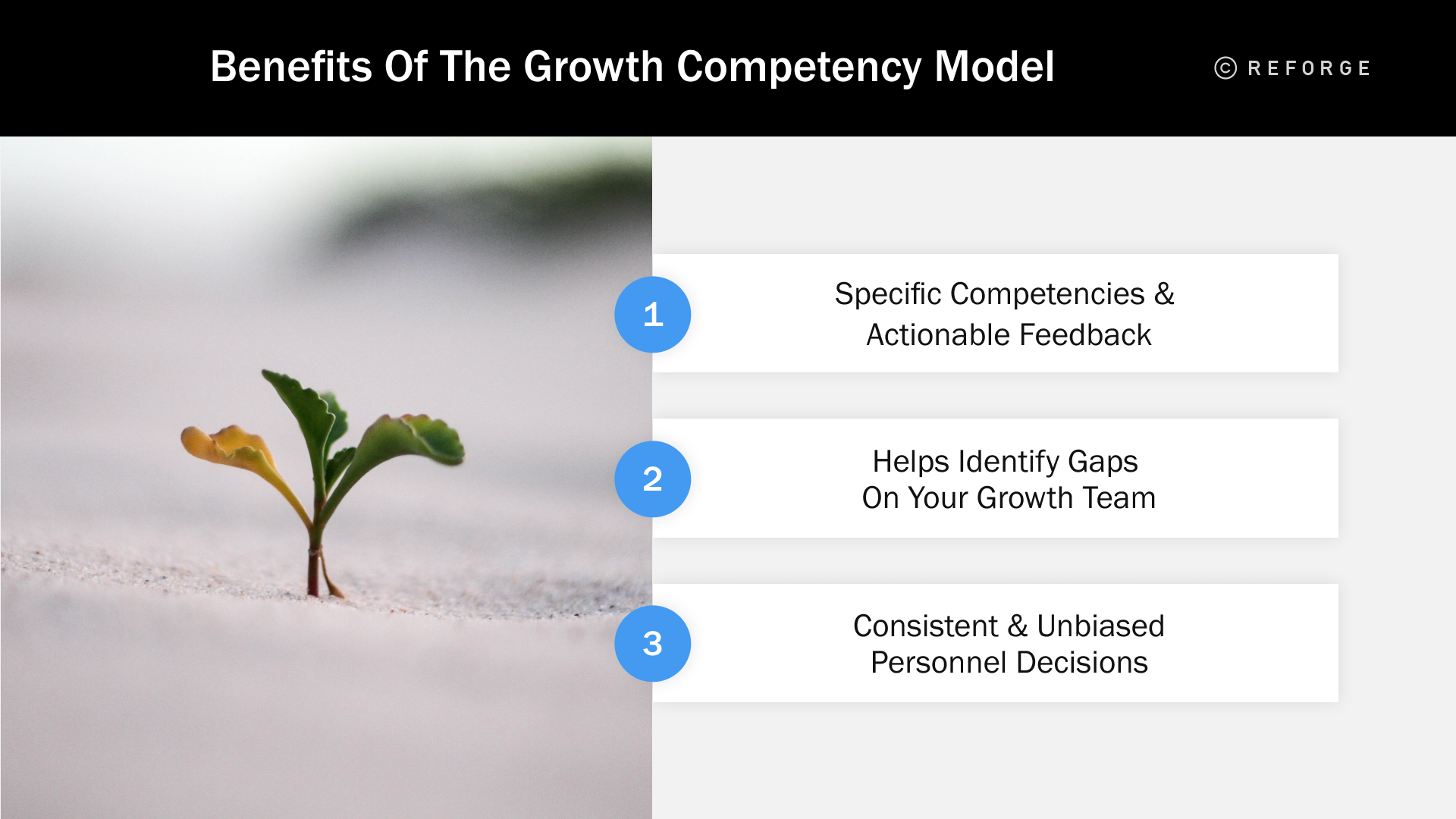
First, it grounds employee performance in competencies that are specific to that job function. The feedback you give to each team member will then be actionable instead of overly generic.
This approach helps you avoid evaluating team members against a set of criteria that aren’t relevant to their job or career progression.
Second, it helps you identify gaps across your Growth organization and know exactly what types of competencies you are missing, or overly weighted towards.
Remember, your job as a leader is to build the strongest organization possible. If your team has a large hole in one of the competency pillars, you won’t be able to do that.
Third, it helps you make the right personnel decisions that are informed by a consistent and structured rubric. Using a fixed rubric leads to more unbiased decision-making and feedback across the entire team.
LINEAR VS EXPONENTIAL FEEDBACK
As mentioned previously, the Growth Competency Model powers your ability to create an Exponential Feedback Loop and avoid the pitfalls of Linear Feedback.

The differences between each are clear, but there are two key parts of the Exponential Loop that you enable with the Growth Competency Model.
The first is root cause identification. Without this specific rubric, you can easily fall into the trap of feedback being too high level and therefore not useful.
If you’ve ever heard, “You need to improve your strategic thinking,” you know what I mean. That piece of feedback is way too high-level and not useful.
Imagine approaching that conversation a different way by saying, “I’ve noticed that your thinking around our Growth Strategy is lacking; specifically identification and prioritization of specific growth levers within our primary growth loop.”
Which one of those two statements would you rather receive as an employee? Obviously the second one, it actually contains a piece of feedback that you can work to improve.
The second part of the Exponential Feedback Loop enabled by our Growth Competency Model is objectivity.
When you have a specific and objective rubric you can provide real feedback on behaviors you observe that meet or miss the mark.
Both of these help remove most or all of the subjectivity and opinion from your evaluation.
Let’s now dive into the specifics of the twelve competencies.
The 12 Growth Competencies
A common pitfall in understanding the Growth Competency Model is to assume that your team members can spike on all aspects.
This is simply not true.
Growth is multi-faceted and your team members will need to lean on different skills throughout the ascension of their careers.
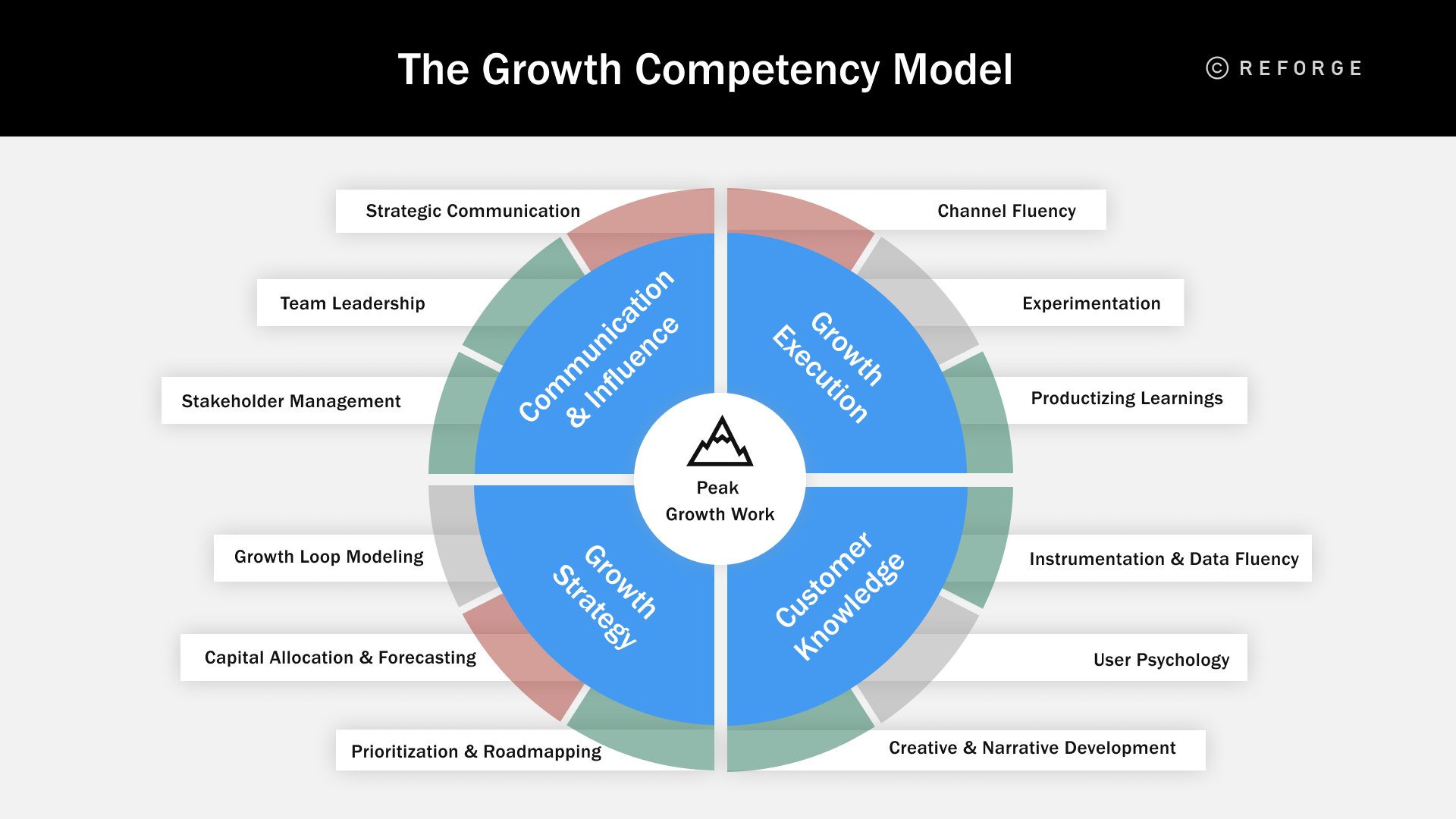
For example, I currently spend more of my time and mental energy on Growth Strategy and Communication.
But earlier in my career, I focused and indexed more highly on Growth Execution and Customer Knowledge.
As a leader, your goal should be to ensure that your Growth organization as a whole does not have any competency gaps.
You can achieve this by hiring new teammates that are skilled in the missing competencies or by coaching your team through the Exponential Feedback Model that we identified above.
So even though your team should collectively spike on most of the 12 Growth Competencies, it’s foolish to assume that every team member is highly skilled in every competency.
Now let’s break down each of those 12 Growth Competencies!
Growth Execution
The first quadrant of importance is Growth Execution, this is your foundation and maps directly to business impact.
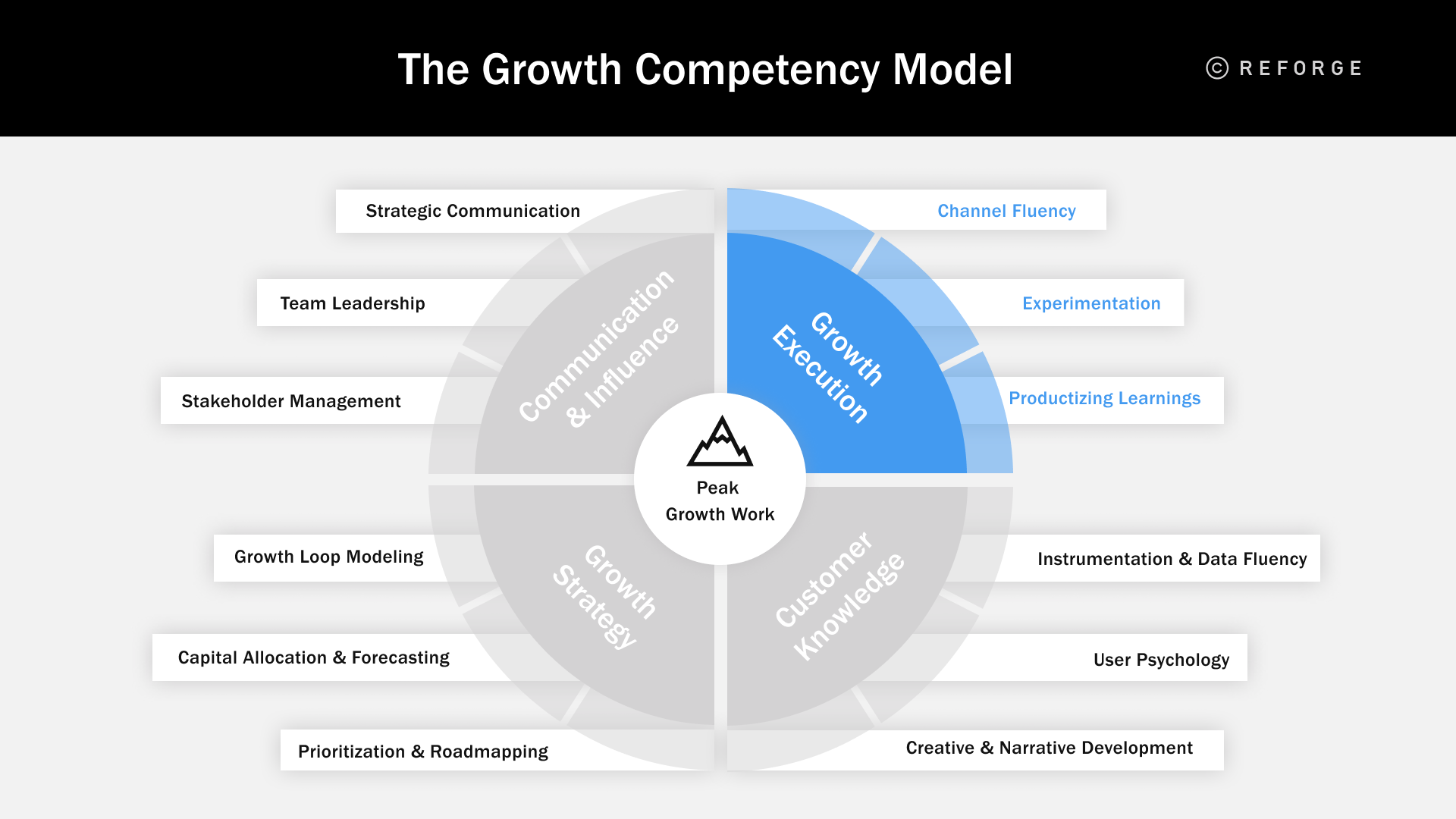
Growth teams who are excellent at execution give themselves a much better chance of achieving long-term, significant outcomes.
The three competencies in this quadrant are Channel Fluency, Experimentation, and Productizing Learnings.
CHANNEL FLUENCY
On a Growth team, the ability to mold your product and marketing to fit an ever-changing channel landscape is critical.
Specifically, Growth requires an in-depth understanding of distribution and engagement channels to drive acquisition, retention, and monetization.
Applying the wrong channel strategy, such as a Paid Loop when your product has a long and unpredictable payback period, leads to unsustainable growth and poor business performance.
In addition, focusing on financially incentivized viral loops, when your product isn’t easily shared, like referrals for a complex enterprise software product, won’t be successful. You’re incorrectly applying a generic channel strategy to your specific product and use case.
The best Growth practitioners understand the full landscape of available channels – across viral, paid, content, and sales – to identify and build high-performing loops.
Adam Grenier, EIR at Reforge, is a proponent of a bottoms-up approach that maps standard channels, and a top-down approach to map the channels customers actually use, when working on the channel landscape for customer problems.
“Yes, everyone is on Facebook… but truck drivers for UberFreight are actively talking about their jobs on YouTube live streams and while socializing at key trucking conferences. Yes, everyone searches for classes on Google and can find a MasterClass… but Neil Gaiman has a very active Reddit group, Ninja’s community is on Twitch, and people wanting to learn Metallica songs on the guitar are on YouTube. And all those channels have fundamentally different DNA to spark growth.”
Now they don’t necessarily have to be experts in each channel, rather they should know how to understand and map channel strategy to the type of product that they’re growing.
One example of doing this well is the cause product Change.org. They were historically powered by a user-generated, company-distributed content loop. Change.org sent petitions out to their member base to grow the number of users.
Recognizing that user distribution was the most scalable channel they pivoted their growth approach to build more levers for user distribution.
EXPERIMENTATION
Armed with the knowledge of the channels and loops, Growth Leaders must then seek the truth through rigorous experimentation.
Remember learning about the Scientific Method as a kid? Competent Growth Leaders or practitioners are likely still using it on a daily basis.
To become an expert in Experimentation, you need to go beyond just a basic understanding of how to run an experiment.
You should be able to build an experimentation engine at your company. If you can’t run experiments at scale, you’re not going to drive real growth.
It doesn’t matter what industry or niche your company falls into, your team should be experimenting all the time.
This includes curiosity and hypothesis generation around the levers that drive your product’s growth, organizing and prioritizing those experiments to maximize learning, designing experiments, and analyzing results.
You can learn more about all of these concepts in the Growth Series.
PRODUCTIZING LEARNINGS
The key to long-term success as a Growth practitioner is your ability to make permanent changes to the product based on new knowledge or data.
As a Growth practitioner, being able to turn an idea or simple experiment into a new product feature is extremely important.
For example, at Patreon we tested the idea of displaying a “locked post” as a way to drive new conversions for creators. The test was executed quickly and considered a huge success.
In fact, it has now been adopted by many other competitive products.
Fully productizing this required building out “blurred” posts which provided more of a teaser of the content and then making those posts look different depending on the underlying locked content.
Moving from the kernel of an idea, that displaying locked posts would drive conversion, to the full production experience unlocked significant value for creators and Patreon.
Timing is an important part of this competency because moving from a minimum viable experiment (MVE) to a scaleable, production-ready change can be resource-intensive and costly.
For example, according to Patrick Moran, EIR at Reforge and former Head of Growth Marketing at Spotify, Spotify’s Discover Weekly automated playlists actually came from a hackathon idea and insights that showed people wanted more ways to discover new music.
Before that new feature, the only ways they were discovering new music were from playlists random people created.
They were able to combine that need for new music with a solution that was tailored specifically for each user. And the rest is history.
Customer Knowledge
Our second quadrant in the Growth Competency Model focuses on the ability to develop a deep understanding of customers and their motivations.
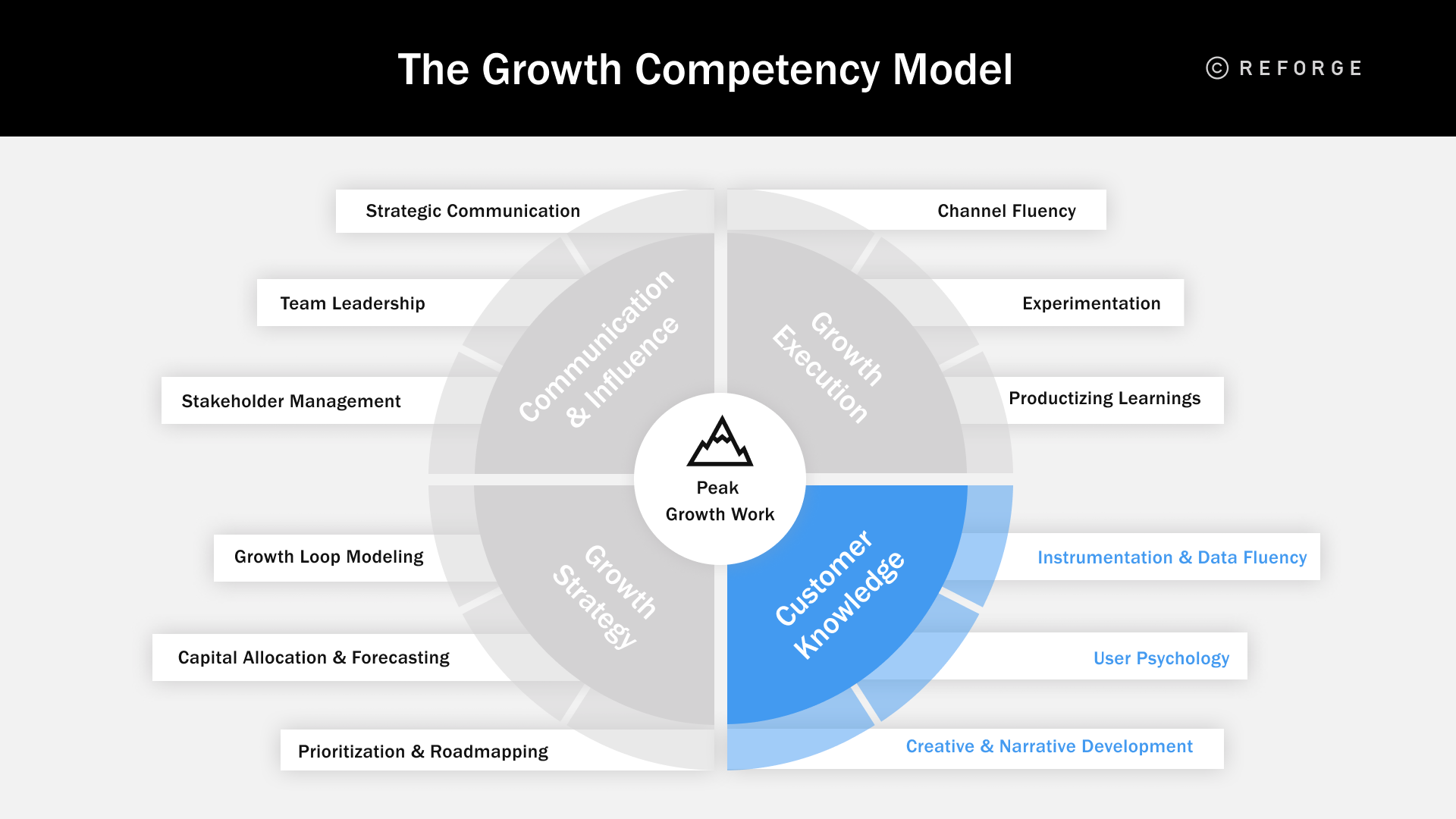
There have been times in my career when a misstep here has caused me to waste valuable time and effort.
For example, at Lyft, our invite-sharing experience was a key factor that influenced driver and passenger growth.
However at the tutoring company WyzAnt, customers didn’t want to share that their kid is seeing a tutor because of the societal stigma. Not understanding this simple customer motivation pushed us in the wrong direction and led to an ineffective invite platform.
Customer Knowledge is an important competency that drives Growth Execution. It is comprised of Instrumentation & Data Fluency, User Psychology, and Creative & Narrative Development.
All of those skills are required to truly understand both what is happening with your customers or potential customers and why it’s happening.
INSTRUMENTATION & DATA FLUENCY
Successful Growth practitioners have expert-level knowledge of data, both qualitative and quantitative, and the tools used to extract that data.
Additionally, they know how to communicate infrastructural needs related to tracking if that tracking doesn’t already exist. Instrumentation needs to be provided if certain data infrastructure is lacking as well.
Quantitative data provides the knowledge of “what” is happening in your growth model.
On the other side, qualitative data coupled with experimentation provides the “why.”
Being able to competently collect and interpret both types of data is an essential skill that every top Growth practitioner should have.
Instrumentation fluency is necessary so that you can develop a complete picture of your customer and Growth model.
Matt Greenberg, CTO at Reforge, thinks that knowing SQL or something similar doesn’t actually make you a great growth practitioner.
Instead, he believes the best growth practitioners should strive to:
“Make data practical for the teams they work with by having a growth model and use cases modeled in a structured way that makes instrumentation and data fluency really shine.”
As a growth practitioner, you need to be able to understand what you want to track and succinctly explain how you plan on doing that to an audience that may not understand the technology.
USER PSYCHOLOGY
Perhaps my favorite aspect of Growth is the ability to understand what motivates and shapes customer behavior.
There are so many questions you can ask in this space, and each answer will help you understand potential consumers a little more.
Questions like:
-
What are the triggers and rewards that form habits and drive repeat usage?
-
What are the motivations that encourage someone to share a product or discourage them from sharing it?
-
What is the key problem that someone looks to my product to solve?
By answering questions like this you can understand who is using your product, why they stick around, and who will benefit from using it in the future.
Customers and prospective customers bring a whole slate of emotions and considerations to a product experience.
For example, the level of motivation to use a product is related to the depth of the customer’s problem that your product solves. And the higher the level of motivation, the more friction they will tolerate when adopting your product.
The most effective Growth practitioners know how to tap into that for maximum impact and effect.
Adam Grenier has seen a lot of Growth teams think they deeply understand their customers because they interact with them constantly. But that never tells the whole story.
“At Uber, we rode with drivers daily and spoke to them. At LambdaSchool our employees were in the classroom and on slack with customers in real-time. But neither of those scenarios replace BEING a driver, dealing with traffic, gas, safety, and more. Or BEING a student while balancing parenting, internet connection, imposter syndrome, etc.”
He believes that the best Growth Leaders can navigate and leverage the difference between perceived and actual user psychology or motivations.
CREATIVE & NARRATIVE DEVELOPMENT
Understanding how to talk to different audiences in a unique way builds on top of insights gained from other aspects of Customer Knowledge.
For example, if you’re a product like Lyft you have a myriad of use cases – a grandma headed to the grocery store, a college student going out for the night, or an executive traveling to the airport.
Knowing how to communicate with these different customer segments and position your products to address their needs is essential. That will influence how successful you are at acquiring, retaining, and monetizing them.
You might approach this creative and narrative development by message testing via experimentation, positioning surveys, and other forms of user research.
Crystal Widjaja, EIR at Reforge and CPO at Kumu has seen how powerful setting the right narrative can be. When Gojeck launched GoPay, an e-wallet, they didn’t get a ton of adoption at first.
So they decided to try to activate one of their most powerful levers, the drivers, by establishing the right narrative and context.
“We’d tell our drivers if a customer hadn’t adopted GoPay yet – and if they did top-up cash with the driver for the first time, the driver would get a bonus.”
Once they had established that narrative, the drivers got creative and took it a step further by running their own promotional strategies for each new customer.
This led to a large spike in driver-led activation rates to GoPay. All because Gojeck was able to give their best activation lever the right context and information.
Growth Strategy
Our third competency category is called Growth Strategy. We cover this extensively in the Advanced Growth Strategy program at Reforge.

Growth Strategy is a long-term view of how your company grows, invests in growth, and will need to adapt in the future to continue growing.
The three Growth Strategy competencies are Growth Loop Modeling, Capital Allocation & Forecasting, and Prioritization & Roadmapping.
GROWTH LOOP MODELING
Growth Loops, and your end-to-end Growth Model, are some of the most critical pieces of your growth strategy.
That information guides how you’ll spend time and money, when you risk reaching a growth plateau, and future hiring plans.
Your Growth Model is also a key communication tool for the rest of the company. It helps you drive strategic alignment with questions like:
-
Is now the right time for growth?
-
How should I design my Growth organization?
-
Are we a marketing-driven growth organization, a product-driven organization, or something else entirely?
The Growth Model is one of the first areas I encourage companies to invest in building out and a key skill to build as a Growth practitioner.
For instance, when I talk to companies who want to start a paid acquisition loop one of the first things we dissect is whether it’s necessary based on their Growth Model.
If they have other loops that need to be nurtured then it doesn’t make sense to focus energy on creating a new loop. This saves them time, focus, and most importantly: money.
At Patreon, our Growth Model was a key communication tool whenever team members asked why we didn’t focus on building for Patrons in the early days. We could show how the growth of the creator base clearly led to a growth in patrons and patronage.
As you can see, not only will an accurate Growth Model help your team stay on track, but it will also help you communicate effectively with the rest of the company.
CAPITAL ALLOCATION & FORECASTING
As a Growth practitioner, you have the added complexity of balancing both headcount and marketing spend.
Many Growth Leaders also oversee the Growth Marketing team, which is responsible for spending a significant portion of the marketing budget. This could represent a rather large expenditure in your company’s budget and directly impact long-term profitability.
As a result, you have a significant influence on the annual plan and P&L of your company. This influence comes in two forms.
First, your ability to generate revenue is driven by how large you grow your userbase and how effectively you monetize them.
Second, depending on your role, you have a big responsibility to manage expenses at a channel level and at an overall budget level.
Patrick Moran adds to this by saying that Growth practitioners should be able to work closely with the finance team to both forecast and manage a budget while integrating that information into the company-wide growth model.
“This competency ties directly back to the ability to develop a learning roadmap driven by the current impact, channel/messaging exploration, and experimentation.”
Being adept at capital allocation and forecasting can help your company more than most Growth practitioners realize. Because of that, it’s often overlooked as an important Growth skill.
I’ve leveraged this skill in just about every single Growth and Product role, so don’t leave it to chance.
Make the investment, it will definitely pay off.
PRIORITIZATION & ROADMAPPING
Knowing how to build a plan that balances both long-term investments and short-term successes is a unique skill that Growth practitioners need to hone.
The order in which you work on projects will influence how rapidly you grow and if that work compounds over time.
Key questions that Growth practitioners need to be asking themselves include:
-
Should you introduce a new loop?
-
Should you be improving an existing loop?
-
What about improving retention or working on something else entirely?
When you decide to ask these questions and how long you work on each can make or break your company. New knowledge from experiments can often throw previous assumptions into question or introduce new questions that have to be prioritized as well.
For example, a few years ago at Patreon we re-priced our entire product in order to improve our monetization. This improvement would yield long-term benefits and allow us to invest more into scaling the business.
It took us a year to work through these pricing changes – alignment, planning, research, building, deploying, and communicating. This long-term investment, a year’s worth of work, led to a radical change in our profitability and P&L.
Without a strong prioritization and road mapping competency you run the risk of an unbalanced portfolio of investments.
Communication & Influence
The final quadrant of the Growth Competency Model is focused on organizational and functional alignment as well as rallying support across the company.

To be completely honest, this is an often-overlooked quadrant but it’s extremely important to master.
Even if you have the best data and ideas you still have to convince others on your team and cross-functional teams to pay attention and get behind those ideas. Just because you believe you’re right doesn’t mean everyone else sees it that way.
The three competencies are Strategic Communication, Team Leadership, and Stakeholder Management.
STRATEGIC COMMUNICATION
Communicating the strategic importance of Growth work can be challenging. This is because Growth is often less about big bets, which tend to be the “strategic” work of the company, and more about a systematic improvement of the levers in your Growth Model.
This is often not particularly shiny or exciting work. Well, unless you’re me, then it’s very exciting.
Elena Verna, EIR at Reforge and Head of Growth at Amplitude, also enjoys this type of work and says that learning how to be an internal growth “salesperson” to the rest of the company is essential.
“There is art in making data, loops, and failed experiments sound exciting and enticing. And it is an absolute prerequisite to building a growth culture. Not even the most successful growth teams will succeed in the long term if they operate on the island without organizational support and buy-in.”
It can also be an uphill battle to fight against the perception that you’re “losing” more than “winning.” Especially when your team is testing a lot of new things.
How you bucket these lessons learned and then communicate them as strategic to the business is a hard problem.
Matt Greenberg thinks that strategic communication is very important because it helps make growth work accessible to the rest of the organization.
“Being able to use data to make things feel clear and the ability to package experiments into a narrative of a strategic outcome sets the best growth professionals apart from those that are just transactionally owning a metric.”
I’ve now had Growth leadership roles at multiple companies where I instituted communication practices that didn’t previously exist.
One very successful type of communication is a weekly email that highlights the most important work from the past week, the key learnings we’ve had as a group, and what we’re going to do about it.
The cadence, content, and distribution of this email helped regularly show the rest of the company the “what and why” of our work. So even as we’re making smaller, incremental progress you can see how it has a growing impact on the business and our strategic priorities.
TEAM LEADERSHIP
You’re only ever as good as your team.
Team Leadership focuses on the ability to manage and mentor direct reports. As well as enable them to successfully deliver on Growth areas, continuously improve against these competencies, deliver meaningful business outcomes, and achieve their career objectives.
You’re also responsible for helping your team maintain a growth mindset and build up a tolerance for failure. In this mindset, each failure should be seen as an additional insight gained about your users or your Growth Model assumptions.
This can be as an individual working cross-functionally with a team like a Growth PM or also a Growth Leader managing multiple reports.
As you move into higher positions of leadership this competency becomes even more important and you’ll spend more of your time working on it.
Your job is to boost up your team when they win and learn something new, be their megaphone to the organization, and set them up for success with a clear strategy and goals.
STAKEHOLDER MANAGEMENT
Stakeholder Management is all about leveraging those around you as allies and supporters in your team’s objectives.
In a landscape where Growth is multi-faceted and still not well understood, this competency is especially important for ensuring the long-term viability of your efforts and garnering the resources you need to be successful.
It’s important to identify the Growth team’s stakeholders early and work with them to ensure their needs and requirements are being considered in your growth process.
Failing to do so can lead to a lot of bad feelings and organizational friction that slows you down when you should be speeding up.
Adam Grenier was able to navigate this in an innovative way when testing creative assets at MasterClass.
“I specifically carved out time and built my relationship with our Executive Creative Director, and focused on appreciating his personal and team goals. By regularly respecting his team’s goals and celebrating them as much as our team when we saw the positive impact we were able to find balance in speed, breaking previous norms, and even hiring more growth-oriented design resources.”
When Growth sits outside of a marketing or product organization this becomes very important because they still must collaborate effectively with these groups.
With that, we can confidently say that we have covered all of the Growth Competencies.
The next question is how do we get started with it at our organization?
This is where implementation is critical.
Implementing The Growth Competency Model
It only takes three key steps to successfully implement the Growth Competency Model at your company.
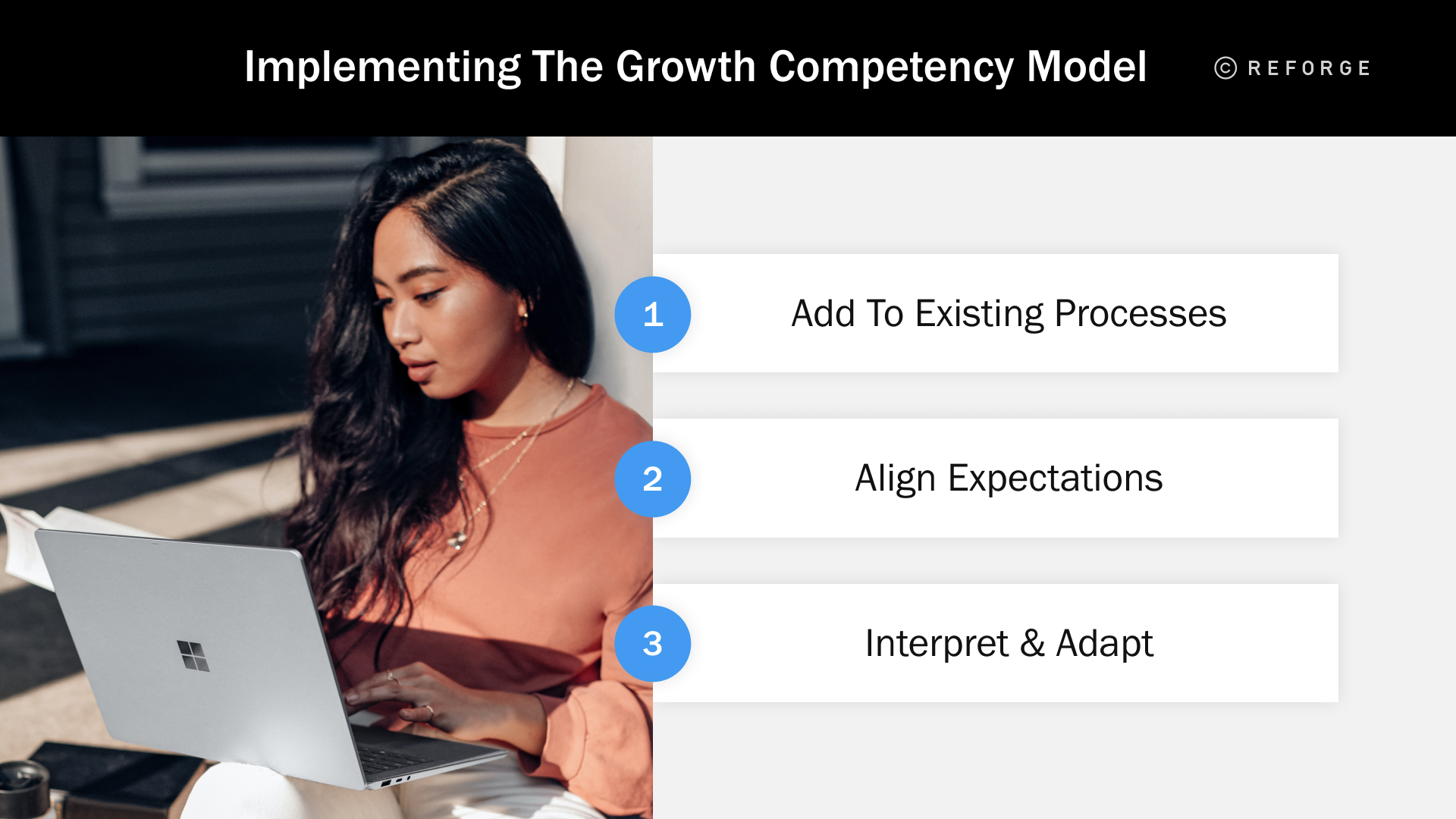
First, avoid breaking your existing evaluation process and instead figure out how you can add the Growth Competency Model to it.
The Competency Model provides a new objective rubric for your evaluation of Growth-specific skills; it doesn’t need to work on a different timeline or fly in the face of company norms.
The second step is to align expectations across the organization so that everyone understands what you’re doing, even if they’re not ready to implement the whole thing yet.
Finally, you’ll want to modify the Growth Competency Model to fit your particular organization and company culture.
Let’s now take a deeper look at each of those key steps.
ADD INTO EXISTING PROCESSES
Your company likely has one of three evaluation processes: open-ended, values, or trait-based.
Or maybe they already have a robust and specific evaluation rubric for your organization. This is okay, the Growth Competency Model can be added to each process!
With an open-ended evaluation process, managers typically answer a set of questions and then provide a rating score.
You might be required to ask some questions like:
-
What did this person do well?
-
Where do they need to improve or what should they do differently?
-
What goals do they have for the upcoming year?
In this case, the Growth Competency Model provides you with a foundational framework to objectively evaluate across all those dimensions.
If there is a team member who has deep channel knowledge but isn’t leveraging customer insights or experimentation to do so they’ll drive a lot of unsuccessful output.
In other words, they’ll get a lot done but it won’t be very effective.
You can bring the Growth Competency Model into this existing evaluation process by focusing on the skills you want the person to develop.
In the case above you could say:
“You index highly on your understanding of channels; that’s a great demonstration of the Execution quadrant in our competency model. However, I’d like to see more emphasis on developing customer knowledge through more effort in data fluency and rigorously testing your hypotheses.”
That type of clear and actionable feedback will help the Growth practitioner level up to where your team needs them to be.
Second, in a values or trait-based evaluation process you might have a set of company standards or values – Amazon has Leadership Principles, Patreon has Core Behaviors, and Facebook has Core Values.
Thankfully, you can add the Growth Competencies as a layer on top of your existing performance evaluation process without straying away from company values or standards.
For example, at Patreon we had a Core Behavior of “Being Candid and Kind.” You can evaluate whether someone on your Growth team embodies that core behavior while layering on their ability to communicate strategically, manage stakeholders and lead teams effectively.
Finally, you may already have a robust, specific evaluation process for Growth-focused teams.
In that case, use the Competency Model to augment and inform your thinking. Or simply update the evaluation process to include pieces of this framework.
You could consider adding certain elements from the Growth Competency Model into your existing evaluation process.
Maybe you have too many existing evaluation criteria focused on Growth Execution and not enough on Growth Strategy. In that case, you can add specific competencies to create more well-rounded evaluation criteria.
ALIGN EXPECTATIONS
The Growth Competency Model provides an evaluation framework for your team members but your company may also have specific evaluation criteria across teams.
In this case, your Competency Model helps bridge the gap between company performance expectations and Growth team expectations.
It’s important that other leaders understand exactly what exceptional performance in Growth looks like. Especially those involved in decisions like promotions, re-alignments, and other cross-team operations.
Not doing this will lead to conflicts across organizations and within the ranks of upper management.
Growth Leaders must be clear to their team, and other leaders, that great performance requires meeting company expectations as well as Growth-specific competencies.
At Patreon, we had a set of company expectations for evaluation and career progression. In addition to both of those, I also had my own set of Growth Competencies for the team.
I made sure that these competencies were clear to other leaders when it came time to review performance and recommend promotions.
Being able to communicate these to the rest of the leadership team led to two positive outcomes.
First, other leaders developed a better understanding of what competencies were important for the new Growth function. Additionally, it provided a framework for other leaders to support my recommendations on promotions, pay changes, and more.
INTERPRET & ADAPT
The Growth Competency Model provides a MECE view of how to build a powerful Growth team and give that team effective feedback
That said, it can easily be adapted to your specific organization and company culture.
For example, the analytical infrastructure might already be outstanding at your company. So instead of having your Growth team focus on extracting data, they should double down on competencies that help them interpret the data.
Or if you have a customer-obsessed culture, your team members may need to spend more time talking to customers and execute fewer, but more impactful experiments.
As a leader, your job is to “read the room” and implement the Competency Model in a way that is best suited for your company, culture, and leadership style.
Employee tenure is another aspect that you should consider when adapting the Growth Competency Model.
I have seen too many leaders highlight a tenured and experienced employee when commenting on a more junior employee’s performance.
Don’t do this! It’s like comparing apples and oranges, especially on the Growth teams.
As mentioned earlier the complexity of the work and the competencies necessary for success will change with someone’s seniority.
I spent years honing competencies in the earlier part of my career that is not very useful to me as an executive.
One way to reconcile this problem is by scoring the importance of various competencies across employee experience levels.
For example, Growth Strategy competencies may only have an “importance level” of 2 out of 5 for a junior team member, but a 4 out of 5 for a more experienced teammate.
In this case, you wouldn’t withhold a promotion or compensation from a junior team member as long as they are spiking on Growth Execution and Customer Knowledge competencies.
You also can use this approach to plot out a career path with them and highlight areas of competency improvement that are needed to cross the chasm from a junior to a senior level.
This allows you to objectively assess and subsequently reward the right behaviors at the right stage of development. You can identify and assign various competencies to different levels in your career ladder.
Remember, your goal with applying the Growth Competency Model is not to ensure that every team member is a 10 out of 10 on every competency. It’s to ensure that you have the right balance of skills to create a well-rounded, diverse, and high-performing team.
Wrap-Up
As you can see, the Growth Competency Model provides a framework for objectively evaluating your team members and your organization across the 12 Growth Competencies.

It’s important that each of these competencies exist in your Growth organization, even if your teammates don’t index highly in all of them.
Trust me, they won’t. But that’s not a bad thing at all!
With this model, you can identify gaps in your organization and make an informed plan to fill each gap. This could be achieved either through hiring new employees or coaching your current team members.
You can also start implementing the Growth Competency Model in a few different ways depending on your company.
Layer it into your existing company-wide evaluation processes while ensuring that other leaders are aligned around your new objective criteria. Then adapt it as needed to better fit your company culture and team composition.
Remember, the role of a Growth practitioner is multifaceted and often ambiguous. With the Growth Competency Model and the Exponential Feedback Loop, you now have a clear, specific rubric to build thriving, retentive, and enthusiastic Growth teams.
